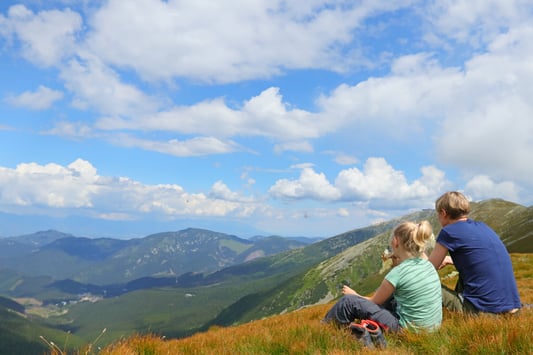Are you the kind of person who stares up at the sky to watch clouds drift by and sees more than just a fluffy white mass? Do you find yourself lost in daydreams while imagining shapes and creatures taking form before your eyes? You are not alone. Welcome to the wonderful world of cloud watching.
It's no secret that the shapes of clouds have fascinated people for centuries. From poets to painters, many have found inspiration in the shapes and formations they see in the sky. But how do you refine your skills in spotting these elusive shapes and creatures? It's not as hard as you might think, with a little bit of imagination and a whole lot of humor.

Mother and Daughter Cloud Watching in Mountains
First, find a comfortable spot to sit or lie down. Make sure you have a clear view of the clouds as you gaze up at the sky. It's best to choose a time of day when the sky is not too bright or overcast and the sun is lower towards the horizon, like morning or late afternoon. Once you are comfortable in your spot it is time to let your imagination run wild.
To find shapes and animals in cloud formations, you have to be willing to see beyond the obvious. There may be a few clouds that look like cotton balls or fluffy sheep, but where's the fun in that? Look for the weird and wacky. Let your mind wander and see what pops up. Is that a dragon flying through the sky? Or a giant octopus stretching its tentacles across the horizon? The possibilities are endless. If you're struggling to see anything in the clouds, try looking from a different perspective. You can also try squinting your eyes or focusing on one spot in the clouds. These strategies can help bring out the details of the shapes your mind is trying to form.
Not all cloud types are conducive for finding recognizable shapes. On overcast days, low-level stratus clouds form a continuous gray layer over the sky. These clouds lack the definition needed for good cloud watching. Sometimes on a sunny day, spotty patterns of high-level cirrocumulus clouds cover the sky, but rarely form distinctive shapes. The best cloud type for finding shapes in the clouds are cumulus clouds. The bottom of cumulus clouds can float as low as 1,000 feet above the ground, but the cloud can reach towards the sky at up to 12,000 feet.
Cumulus clouds are formed by convection, where warm air near the surface of the ground cools as it is lifted by small thermals and condenses into water vaper to create a cloud. It is not common for cumulus clouds to produce precipitation, making sunny cloud watching days even more enjoyable. Clouds move quickly due to strong winds at speeds of 30-250 mph. Since clouds are made up of condensed water droplets, the particles within the clouds can move at different speeds and directions, meaning the cloud shapes are constantly changing. A cloud that looks like a dolphin can quickly change into appearing as a horse, so pay close attention!
One of the most enjoyable ways to find shapes and animals in cloud formations is to play a game with your friends or family. Challenge each other to find the most creative shapes or the funniest shapes. Not only is this a fun way to pass the time, but it also encourages creativity and imagination. Don't be afraid to get silly with your cloud watching. Make up stories about the creatures you see in the sky.
With a little bit of imagination and a whole lot of humor, you can turn a simple cloud into a work of art. So, grab a blanket, find a comfy spot, and let your mind soar with the clouds. Who knows what kind of creatures and shapes you'll discover?
Lara Carlson is the Senior Programs Director at Walking Mountains Science Center. She enjoys taking breaks while hiking to stop under a comfortable tree and watch the art the clouds form across the sky.







